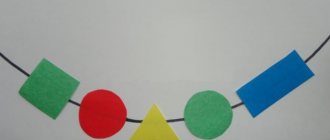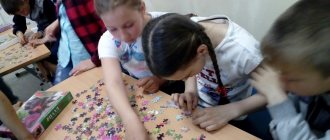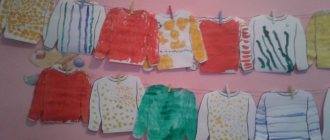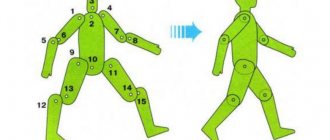Summary of a lesson on speech development “Journey through fairy tales” in the middle group
Irina Duklis
Summary of a lesson on speech development “Journey through Fairy Tales” in the middle group
Summary of a lesson on speech development in the middle group “ Journey through Fairy Tales ”
Goal: Consolidating knowledge about Russian folk tales - names , characters, their dialogues, sequence in fairy tales .
• Learn to recognize Russian folk tales ;
• Develop memory , attention, logic.
• Develop speech activity through the use of small folklore forms, develop interest in artistic expression and children's pictures.
• Develop a positive attitude toward participation in the lesson , friendly relationships, and cooperation skills.
• Foster mutual assistance, friendliness, caring attitude towards animals, love for loved ones and nature.
Methodological techniques: surprise moment, conversation, answers to questions, game, encouragement.
Preliminary work: reading fairy tales , looking at illustrations, playing games based on fairy tales , guessing riddles.
Equipment and materials: pictures with illustrations, selection of riddles, selection of objects from fairy tales , chest, bun, letter, stickers, bell
Progress of the lesson:
- All the children gathered in a circle!
Let's hold hands tightly
And let's smile at each other.
- Guys, here we are in the land of fairy tales and the first task awaits us. I suggest you sit comfortably on the chairs.
-We received a letter today. Let's read and find out what kind of letter this is and who it is from. (open the envelope and read)
Q: – And to get to a fairyland , you need to know and love fairy tales . Do you like fairy tales ?
Q: Do you want to go on a fabulous journey ?
Q: I have a magic bell. And in order for us to get into a fairy tale , we need to close our eyes and say the magic words:
One two Three! Get into !
Q: Guys: open your eyes! Here we are in a fairy tale ! Oh, there's a chest here. What's in it? And here is the Fox’s first obstacle that we need to overcome in order to move on.
They open the chest and find a ball and a note: “In order for the ball to lead you further through fairyland , you must answer my tricky questions. Here's a magic flower for you. Tear off the petals and find out the tasks"
- What song did Kolobok sing?
- What did Mashenka say to the bear while sitting in the box?
— What did the animals ask in the fairy tale “Teremok” before entering there?
- What words did the cockerel shout when he wanted to drive the fox out of the hare’s hut?
- What words did Mishutka say when he saw the broken chair?
Q: Well done children, you coped well with the first test.
Q: I suggest you rest a little - physical minute: “Turnip”
The turnip has grown big. That's what it is! That's what it is! (arms to the sides, up, down)
Grandfather and grandmother are pulling the turnip, but it is stuck tightly. (bends, squats)
The granddaughter runs and runs towards them, in a hurry to pull out the turnip. (running in place)
The bug wags its tail and helps grandma and grandpa. (turns right, left)
The cat arches its back, the cat releases its claws. (bend over backwards)
It helps to pull the turnip, but it is stuck tightly. (squats)
With the mouse they quickly and skillfully pulled out the turnip. (jumping up on two
Q: We need to move on, because there are still fabulous trials that the fox has prepared for us.
(the teacher throws the ball towards the easels)
You roll, roll, ball,
Just don't rush too much,
Show me the path.
Q: To complete this task, let's stand in a circle. Game: “ Fairytale Lotto ”
.
(children stand in a circle, the teacher throws the ball into your hands)
Q: I throw the ball into your hands and say the first word, and you guess the name of the fairy tale .
The wolf and the seven Young goats)
Cockerel (and bean seed)
I will show illustrations, and you look carefully and tell me a fairy tale .
4. "Zayushkina's hut"
,
5. "The wolf and the seven Young goats"
.
6. "Cat Rooster and Fox"
8. "Sister Alyonushka and brother Ivanushka"
.
A bun appears: “Thank you guys for your help! fairy tales so well that thanks to your correct answers to the Fox’s tricky questions, I found myself back in my fairy tale !”
Q: Well, guys, we helped Kolobok get into his fairy tale , and it’s time for us to go to kindergarten.
Educator: Guys, today you solved interesting and difficult tasks for the Fox. They helped Kolobok return home.
- Which country did we visit? ( "Land of Fairy Tales "
)
- Who confused all the paths? (Fox)
- Name the fairy tales that you remember?
— What did you like most about our trip ?
As a token of gratitude, I have a surprise for you - these are stickers with characters from your favorite fairy tales
Summary of the final lesson on speech development in the senior group “Travel to the Arctic” Objectives: To clarify and expand children’s knowledge about the Arctic, about the animal world of the Far North: appearance, habits, nutrition, fitness.
Summary of the final lesson on speech development in the senior group “Journey to the country of Correct speech” “Journey to the country of Correct speech.” Program content: Educational: • Reinforce the use of nouns in speech. Summary of the final lesson in the middle group “Journey through fairy tales” Goal: To consolidate the skills of quantitative and ordinal counting, the ability to distinguish familiar geometric shapes (circle, square, triangle,...
Notes of an open lesson on speech development “Journey to the Island” in the senior group Notes of an open lesson in the senior group on speech development “Journey to the Island” Purpose: Creating a social situation for speech development.
Summary of an open lesson on speech development in the middle group “Journey through fairy tales” “Journey through fairy tales.” Targets: the formation of an emotional attitude towards fairy tales. Objectives: 1. Teach children to recognize familiar things. Summary of an open lesson on speech development in the senior group “Journey to the Land of Beautiful Speech” Purpose: To summarize the knowledge acquired during the first half of the academic year. Objectives: Educational: – enrich vocabulary through.
Summary of an open lesson-entertainment in mathematics in the middle group “Journey through fairy tales” Purpose: To test the children’s ability to apply the knowledge acquired in class when completing tasks in a game setting. Program content: Educational.
Summary of an open lesson on speech development in the preparatory school group “Journey to the program “My Family”” Objectives: to form elementary ideas about the pedigree; consolidate children’s ideas about family relationships; improve.
Summary of a lesson on speech development in the middle group “Autumn Journey” The purpose of the educational activity is to create conditions for the development of children’s speech activity on the lexical topic “Wild Animals”. Objectives: Educational: • Intensify.
Source
Methodological features of viewing paintings in different age groups
Methods of teaching monologue speech
Storytelling from a picture
In the method of speech development, teaching storytelling from a picture (description and narration) has been developed in sufficient detail. Here the methodology is based on the classical heritage of Western and Russian pedagogy, later used in relation to work with preschool children by E. I. Tikheeva, E. A. Flerina, L. A. Penevskaya, E. I. Radina, M. M. Konina and others. All of them emphasized the great importance of pictures both for the general development of children and for the development of their speech.
In developing the skills to describe pictures and compose narrative stories, specially designed series of didactic paintings of different types (subject, plot, landscape, still life) are used.
Landscape paintings: A. Savrasov “The Rooks have Arrived”; I. Levitan “Golden Autumn”, “Spring. Big Water", "March"; K. Yuon “March Sun”; A. Kuindzhi “Birch Grove”; I. Shishkin “Morning in a pine forest”, “Pine forest”, “Forest cutting”; V. Vasnetsov “Alyonushka”; V. Polenov “Autumn in Abramtsevo”, “Golden Autumn”, etc.;
Still life: K. Petrov-Vodkin “Birch cherry in a glass”, “Glass and apple branch”; I. Mashkov “Rowan”, “Still Life with Watermelon”; P. Konchalovsky “Poppies”, “Lilacs at the Window”.
When selecting paintings for storytelling, a number of requirements are imposed on them:
— the content of the picture should be interesting, understandable, and foster a positive attitude towards the environment;
- the picture must be highly artistic;
— images of characters, animals and other objects must be realistic; a conventional formalistic image is not always perceived by children;
— you should pay attention to the accessibility of not only the content, but also the image. There should be no pictures with an excessive accumulation of details, otherwise children will be distracted from the main thing. Strong reduction and obscuring of objects makes them unrecognizable. Excessive shading, sketchiness, and incompleteness of the drawing should be avoided.
One of the techniques that prepares children to tell a story based on a picture is looking at and talking about its content.
Children do not know how to look at pictures, cannot always establish relationships between characters, and sometimes do not understand how objects are depicted. Therefore, it is necessary to teach them to look and see the object or plot in the picture, to develop observation skills.
Methodological features of viewing paintings in different age groups
The role of pictures for young children is primarily to consolidate and deepen children's experience and only to a small extent to expand it.
Examination begins with bringing in the picture and silently contemplating it. But since the kids cannot silently look at the picture, the teacher maintains the conversation, draws their attention to the object or character and gradually develops the conversation. The main methodological technique here is questions. With a question, the teacher immediately identifies the central image (Who do you see in the picture?), then other objects, subjects, and their qualities are considered. This is how the perception of the picture proceeds consistently, bright details are highlighted, the vocabulary is activated, and dialogue develops. In addition to questions, explanations and game techniques are used (children are asked to mentally put themselves in the place of the child who is drawn, give a name to the character; the game “Who will see more?”). The sequence of questions ensures a holistic perception of the picture, and game techniques maintain interest in it. Such an examination of the picture comes close to a conversation between a teacher and children.
A more complex type of viewing is a conversation based on a picture. It differs from the previous lesson in greater focus, systematicity of questions, consistency of consideration and the mandatory participation of all children.
Here, in addition to questions, the teacher’s generalization, prompting of the right word, and children’s repetition of individual words and sentences are used. The conversation ends with a summary story. In such a conversation, choral responses predominate. It is difficult for children to remain silent and maintain attention to the picture while giving individual answers. Their speech reactions are slow.
When examining pictures, the teacher takes into account the interests of the children and their psychological characteristics. So, if the picture is dynamic (“Cat with kittens”), it is better to first of all draw children’s attention to the dynamics and actions of the characters (a playing kitten). If the picture is bright, colorful, or it depicts something that catches your eye, that’s where you should start looking (“Chickens” - a bright rooster). It is not recommended to show the picture to children in advance (before the lesson), since the novelty of perception will be lost and interest in the picture will quickly disappear. Independent perception in children is not sufficiently developed.
In middle preschool age, more complex subject and plot pictures are recommended for viewing (“Gifts for Mom on March 8th”, “Dear Guests”, “On the River”, “Visiting Grandma”)1. Some of them are given only for viewing, others - for viewing and subsequent telling.
Conversations based on pictures become more complex, children learn to see not only the main thing, but also the details. In the painting “Dog with Puppies,” for example, attention is drawn not only to the dog and its puppies, but also to the sparrows and their actions. During examination, you can offer to describe one of the objects, drawing on children's experience. So, in a conversation about the painting “On the River”, you need to give the opportunity to admire the river, the blue sky, the steamboat that is carrying many passengers, and then move on to looking at those on the shore, ask if anyone has ridden a boat or sailed on a steamship. In conclusion, you can read a story on this topic.
In older preschool age, when talking about pictures, special attention is paid to a more detailed examination due to the greater complexity of the content. The picture can be viewed in parts. First, the main thing, then the details that children should notice for themselves. For subsequent descriptions, you should pay attention to the interior, background, landscape. It is also important that the child express in figurative words his personal attitude towards the perceived landscape, river, forest. In this regard, you can choose epithets and comparisons with your children.
E. P. Korotkova recommends using questions that develop imagination and creativity. So, when looking at the painting “Autumn Day,” talking about two boys going to school, you can ask: “What do you think they can talk about?” Based on the painting “Winter Fun,” to activate the imagination, you can ask the following question: “If you come closer to the place where the kids are having fun, what can you hear?” The events that children talk about will be associated with sound impressions: you can hear the snow crunching in the cold; You can hear children laughing and cheerful screams. Children then incorporate these facts into their stories.
The invitation to ask questions themselves will increase children's activity. For example, during a lesson on the painting “Hedgehogs,” a riddle is asked about a hedgehog. Children are reminded that they already know a lot about hedgehogs (what they eat, how they curl up into a ball, how they snort angrily). Then they are asked to think about what else they would like to know about hedgehogs and ask a question. Children may want to know how hedgehogs make burrows, what hedgehogs are born like, and whether they grow quickly. Next, they look at a picture that helps answer these questions. With his explanations, the teacher clarifies the children’s ideas. At the end of the conversation, it is legitimate to ask: “What new did you learn from the conversation?” (Example of E.P. Korotkova.)
To activate speech and thinking, such techniques as asking children to think (“What else would you like to know?”), indicating in what form to carry it out (“Ask questions”), leading children to a generalization (“What new things have you learned?”) were used ?).
The development of creativity is facilitated by the technique of children coming up with a title for a picture, discussing it, choosing the most successful one, and comparing it with the real title.
In the methodology of speech development, there are several types of children's stories based on the picture.
1. Description of object paintings is a coherent, sequential description of the objects or animals depicted in the picture, their qualities, properties, actions, and way of life.
2. Description of the subject picture is a description of the situation depicted in the picture, which does not go beyond the content of the picture. Most often this is a statement of the contamination type (both a description and a plot are given).
3. A story based on a sequential plot of a series of paintings. The child talks about the content of each plot picture from the series, linking them into one story.
4. Narrative story based on the plot picture. The child comes up with a beginning and an end to the episode depicted in the picture. He is required not only to comprehend the content of the picture and convey it in words, but also to create preceding and subsequent events with the help of his imagination.
5. Description of a landscape painting and still life.



